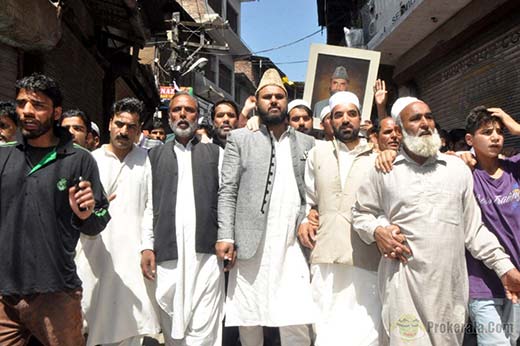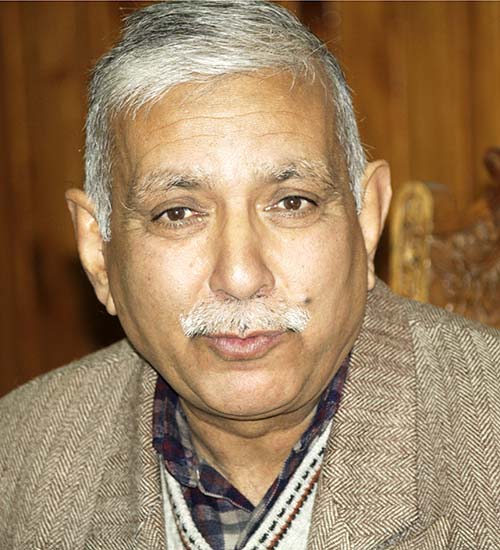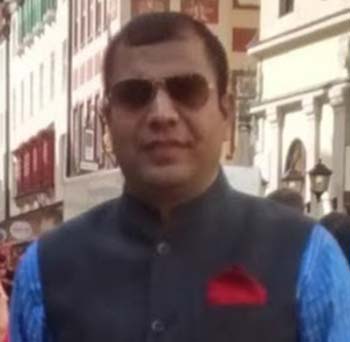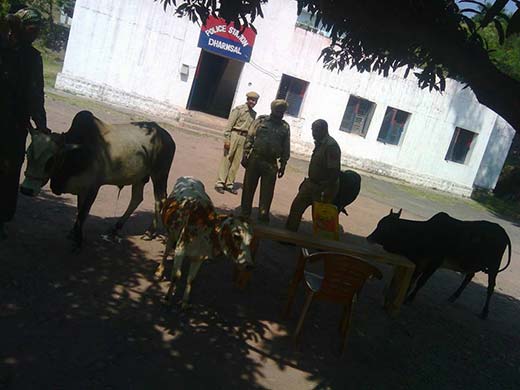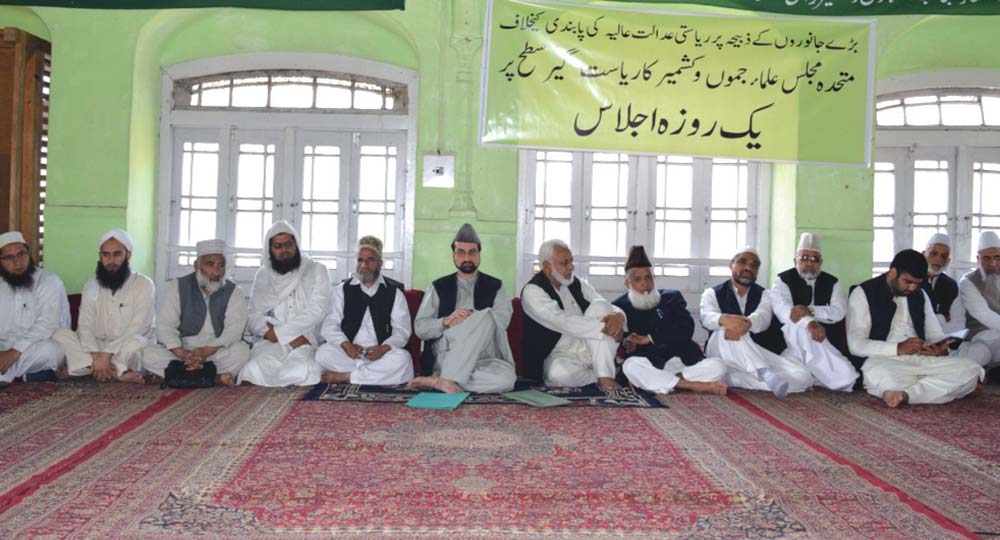For nearly 200 years, beef was a whisper and not the talk. Then, hearths would go up in flames with homes and the human resource if it cooked beef. Fear of reprisals created a new folklore and literally converted a vast chunk of beef-eaters into exclusive mutton-consumers, especially in urban and sub-urban Kashmir. That is why cow is still short of being worshipped legally in J&K, India’s Muslim majority showcase. As right-wingers took the judicial route to revive their core competence, R S Gull outlines future of beef, butchery, law and politics
After surviving a crucial surgery post-retirement, Prof Syed M Afzal Qadri, the erstwhile head of University of Kashmir’s Law department is living a calm life. Driving around to his friends and relatives and raising his grand-children, Qadri is the proverbial happy-go-lucky man. Last week, he made news. The reason is the cow, a bovine currently sitting over the emerging discourse and literally over the future of the ruling ‘south pole-north pole’ coalition. Qadri is aghast over a criminal code clause that is in conflict with his fundamental rights, his right to food, life and faith.
But Qadri’s Public Interest Litigation (PIL) is a reaction to another PIL that lawyer Parimoksh Seth filed in 2014 seeking strict implementation of section 298 of the Ranbir Penal Code (RPC) in J&K. Section 298 details utterances aimed at hurting religious sentiments. Under 298-A, voluntary slaughtering or killing cow or the like animals is punishable by 10 years. Under 298-B, possession of flesh of these animals can lead to an imprisonment of one year and a fine of Rs 500. 298-C empowers courts to impose fine to the extent of five times the cost of a buffalo that is slaughtered or killed and 298-D empowers courts to punish by sending individuals to jail for a month and a fine of Rs 400 for possessing un-tanned hide, meat or flesh or carcass of a gond.
Petitioner Parimoksh, son of key RSS man Onkar Seth, was appointed state’s Deputy Advocate General after BJP aligned with PDP to rule J&K. His petition had home department as a respondent. State’s home department was represented in the court by Vishal Sharma, son of Vishwa Hindu Parishad (VHP) leader Leela Karan Sharma, who headed the Shri Amarnathji Sangarh Samiti (SASS) in 2008 land row. Another pleader for the state is Sunil Sethi, the spokesperson of the BJP. The court directed police last fortnight to strictly enforce section 298 in the state.
It embarrassed government. “We were taken by surprise not because we could have stalled the direction but because we had no inkling of what was happening,” a law ministry official said. “It seemed as if it was pre-planned.”
As the news about the court upholding beef ban, already enshrined in the laws in vogue, spread, reports of cow slaughters in immediate retaliation started pouring in. Cutting across political ideologies, people found themselves on the same page. Not even BJP felt different. Khursheed Malik, who contested 2014 assembly election from Kokernag for BJP unsuccessfully, shocked his own party. “I have decided to organize a party for both Hindus and Muslims,” Malik told a newspaper. “The Muslims will be served beef and the Hindus an exclusively vegetarian meal. This party will send a message of religious tolerance, brotherhood and secularism.”
In a bid to prevent separatists from using the issue (they already sponsored a day long strike), officials requested the petitioner to withdraw the case because Deputy Advocate General cannot fight a case against the state that appoints him. He took his time and eventually refused – he was willing to change the petitioner but not the petition. His party wants him to stay put because he is on the “right side of the law”. Tension is brewing up on communal, regional and party lines. Red faced government shifted Sharma out of home and replaced him by Wasim Sadiq Naragal.
In Hazratbal’s Professors’ Colony, Qadri sees gross injustice in the continuation of RPCs Section 298 and wants it to be deleted altogether. In his PIL, that his son Faisal filed, Qadri has listed a series of reasons making it a burden on him as a citizen and a Muslim.
Firstly, the particular sections of the RPC were conceived in 1932 by an autocrat and were incorporated in the penal code subsequently post-partition. These sections, he avers, are not in conformity with the set of fundamental rights that constitution of India bestows on its subjects.
Secondly, these provisions obstruct an individual’s right to choose his food in his personal life and violate the right to life.
Thirdly, the provisions are in confrontation with the obligation of Muslims to offer animal sacrifices and thus compromises their right to practice a faith. Mentioning specially that a bovine suffices the sacrificial obligations of seven Muslims in comparison to one in case of a goat or sheep, the provisions of 298 RPC imposes a “substantial burden” on the faithful both in terms of money as well as the punishment which is unconstitutional and disproportionate.
Fourthly, while there could be room for reasonable restriction, the impugned provisions completely suspended and abolished rights enshrined under the Article 25 of India’s Constitution. Besides, it criminalizes an activity with a decade long imprisonment.
Division Bench comprising Justices M Yaqub Mir and B L Bhat directed the state to file response. “The court has directed the government that the petition or the sub-judice nature of the case should not come in between if the lawmakers opt for an amendment or deletion of the provisions in the state assembly,” Faisal said. “The ball is literally in the court of the government.”
Regardless of what happens on the streets in Srinagar and Jammu, there are two crucial cow tests in line. Firstly, this Eid when Muslims are obligated to offer animal sacrifices there are indications Srinagar may have more beef available than mutton. In south Kashmir’s Islamabad, clerics have started a campaign for offering only bovine sacrifices and that too collectively. Unlike Kashmir, the real danger is lurking in Jammu’s Muslim belts which can trigger a crisis.
In Srinagar, Mirwaiz Umar assembled the clergy who ruled that no court, government or individual can prohibit what is lawful in Islam. They actually asked Muslims across the state to defy the ban.
“We want the government to bring an ordinance to prevent an explosive situation on Eid-ul-Azha where traditionally cow sacrifices are commonplace all across the State,” former finance minister Abdul Rahim Rather said.
Secondly, in the brief October session of the state legislative assembly, the issue is anticipated to be milked by all parties. Engineer Rashid who claimed to have slaughtered two cows in Handwara is piloting a bill seeking deleting 298 RPC. NC lawmakers Ali Mohammad Sagar, Mian Altaf and Akbar Lone are also submitting a similar bill. Their colleague Qaisar Jamsheed Lone, a member of legislative council, has also brought in a bill.
Legal and constitutional experts said it can be done with simple majority. “If the lawmakers vote on communal basis, it will go in five minutes,” one top officer said. “But democracy has its limitations in J&K.”
But what is missing in the debate is Jammu, its cow-belt versus the Muslim areas. It is latter that is facing the brunt.
Kashmir requires almost 35000 bovines a month – a net requirement of an estimated four million kilograms of beef. It generates a monthly business of Rs 80 crore – nearly Rs 1000 crore a year. And it is rarely known that most of the bovines that Kashmir consumes are sourced from Jammu, Punjab, Himachal and Delhi. People who keep the supply lines to Kashmir running are the real sufferers of impugned penal clauses. They are, however, unrepresented in the debate.
Bovine movement is risky and complicated affair. “If it has to be legal, it has a complicated process,” said a Jammu based reporter. “The buyer has to get the seller’s affidavit and record the statement before the Deputy Commissioner and once he is convinced the deal is fair, he issues an order.” There are practical difficulties in managing this, especially if cattle are bought outside J&K. So skipped the system has its own consequences.
In Jammu’s cow belt from Kathua to Ramban, organized civilian vigilantes are always on a lookout for trucks carrying cattle or herds being moved by people. They are stopped, beaten, the cattle are taken away and the “accused” are handed over to the police.
Not reported, there are instances of trucks carrying animals being intercepted, bovines freed – and in certain cases looted, and the carriers set afire. The latest was on August 25 near Bajalta (Nagrota) where a mob intercepted two carriers near Athem and burnt them and later posted the video on Facebook.
On May 7, 2013, a Kashmir-bound truck was intercepted near Nandani and set afire after all the cattle were taken away. Trucker was carrying permission but the mob did not listen. Two more trucks – one each at Jammu and Udhampur, were seized.
One of the two trucks was set afire by a mob at Ghagwal in Samba on April 27, 2014. They were carrying cows and oxen.
Samba is witnessing an interception almost every two days and sometimes ten seizures a day.
“During the peak of governor’s rule, I have personally seen a couple of middle aged men, tied in ropes and kept as hostages for days in front of the police headquarters in Jammu for bovine transportation,” a minister in coalition government said. “Nobody dared to intervene.”
A reporter from Jammu said a Gujjar from Vijaypur was caught by a mob and almost lynched for carrying two cows. “It was only after hours of staying tied with ropes in the main chowk that it was found the cows belonged to him and he was merely shifting them to a different pasture,” he said. “Even the movement of milch cows which are unlikely to be butchered for their beef is a risky business.” Mobs presume all bovine being transported are for beef.
Though the bovine traders, officially termed smugglers, are invariably Muslim, there are Hindus as well. In December 2011, a massive crisis erupted in Chak Harnia belt of Bishnah when a Hindu bovine trader Tilak Raj and his group was accused of killing a civilian Mohan Lal and leaving his three sons injured. The slain was accused to be police informer which had allegedly infuriated the bovine dealers. The killing sent a local mob attacking the police station for revealing the identity of the informer.
Bovine smuggling is always a key issue in Samba, Kathua belt, routinely disrupting law and order. On July 26, 2010 the locals in Samba claimed they intercepted a gang with a herd and caught one of them, later identified as Mukhtiar Ali. This infuriated the local VHP, Shiv Sena and other right-wingers who got BJP’s Hira Nagar MLA and sat on a dharna blocking the highway. They even attacked the police forcing them to fire almost a dozen rounds in air for restoring order. Almost thirty people were injured.
Interesting part of the story is that the police skip invoking 298 RPC every time because it requires evidence for cow slaughter and possession of beef. “We invoke 188-RPC under which we have authority to intercept anything going against an order that Deputy Commissioner has issued,” one police officer who has served the ‘cow belt’ said. “Every year the DC issues an order banning the movement of bovine unless permitted by him and that is the offence that we invoke to get into this smuggling.”
Sometimes, these actions trigger tragedies. On April 16, 2013 a terrible instance was reported from Nagrota. A truck (JK02Q 5097) allegedly carrying bovine animals jumped a check-post twice and later chased. Police said many cops were injured by the speedy truck. As the chase got closer, the driver Manzoor Ahmad (Ramgarh Baggar, Batote) was crushed to death between two vehicles.
Not many people have looked into this area of policing. It is a severe crisis. Its magnitude can be gauged by the fact that the then IGP Jammu Dilbagh Singh told reporters on November 4, 2011 that “during the past four months” the police booked “under the relevant laws” as many as 821 persons for “smuggling of bovine animals to Kashmir valley”. In just four months the police arrested 821 smugglers, seized 353 vehicles and around 4000 bovine animals in 391 cases!
In October 2012, another top officer revealed that in the “last nine months” they arrested more than 700 people in 400 cases of bovine smuggling. They seized 330 vehicles and “rescued” 3400 bovines.
The latest entry of the “bovine smuggling” is the use of Public Safety Act against the “smugglers”. Asgar Hussain and Mohammad Razaq of Shergari (Reasi) were arrested on September 28, 2010 under PSA. They spent a year in Kot Balwal jail.
Nazir Ahmed of Palai (Kathua) was arrested under PSA on June 29, 2011 and imprisoned in Central Jail Jammu.
In Samba, police arrested Mohammed Hussain son of Lal Hussain of Manohar Ghopla of Samba and Mohamed Iqbal son of Noor Ali of Madhera Samba under PSA in March 2014.
Saif Ali of Maggar Khad (Kathua) was arrested on March 15, 2014 under PSA. A habitual offender, police said, he was charge sheeted five times and convicted thrice but never changed.
The latest PSA was reported from Poonch in August.
And in case there is a report of a cow-slaughter, it is a bigger law and order issue. The latest was in July 2014, when a mob rampaged into Bhoond belt of Basohli, abode to a handful of Muslims. They set afire a few shops and within minutes the Bani, Basholi, Mahanpur and Billawar towns were on streets. Authorities imposed curfew restrictions and somehow managed the Eid celebrations under the shadow of the gun. Border Kathua district has 11 percent Muslim population.
In last six years, there have been as many as 28 cases registered for cow slaughter in Jammu region, mostly in the Muslim majority areas. It includes one in which a Kashmiri living in Chenaini was suspected of cooking beef!
But the beef-eating Kashmiris’ anger is completely a different story. Its seething anger has psychological, historical and religious reasons. It is part of their folklore. The adage Mei Kya Hathiya Kaer Meh (Did I murder a cow?) explains it. It was one of the few terrors that symbolized Sikh and Dogra terror.
Cow slaughter prevailed in Kashmir throughout history. During the reign of Sikh governor Dewan Moti Ram, it was banned on basis of a petition by Kashmiri Pandits, and made punishable by death during his 14 months rule in 1819-20. He enforced it strictly when he was reappointed for two years in 1822.
It was, however, during the tenure of Dewan Chuni Lal (1825-27), historian G M D Sufi writes in his Kashir: Being a History of Kashmir, when Khawaja Mohiuddin Kaos and his son-in-law Mirza Kallu son of Khawaja Sidiq Kaos were hanged. Quoting Ghulam Nabi Khanyari’s Wajiz-ut-Tarikh, Sufi says they were well known merchants of the city. “Their dead bodies were dragged through the streets of Srinagar for the alleged offence of cow slaughter,” Sufi recorded.
“Kashmir histories (like Wajiz and Hasan) refer with tragic sadness to Sikh savagery in burning alive a whole family of 17 in dry willow and cow dung because of their alleged crime of cow-slaughter by Pirzada Samad Baba Qadri of Chatabal Srinagar,” Sufi recorded the 1845 massacre. “This dastardly execution was supervised by the Thanadar Bholka Nath.” A R Khanday in his Sikh Rule In Kashmir mentions another such massacre in Hawal involving 12 members of a family.
While Treaty of Amritsar in 1846 led Gulab Singh’s takeover and changed the master of Kashmir, the cow remained unchanged in her status. In certain cases, it actually worsened. Pratap Singh, for instance, “would look at a cow rather than any non Hindu as the first thing in the morning”.
Unknown author of Letters From India and Kashmir visited the valley in summer of 1870. In his Letter XIV titled Kohala To Srinuggur, he records his shock over the omission of beef price not available in Kohala, the gateway to Kashmir. “To kill one of them is a capital crime and opposed as His Highness is to capital punishment, or to the cutting off of a whole neck at once as the taking of life is contrary to Brahminical law yet anyone convicted of cow- murder, would be sentenced to imprisonment and punishment, from which death would be the hoped-for release.,” the author wrote. “Those animals, however, that die from old age, accident, or disease, may be eaten by the Pariah caste both of Hindoos and Mussulmen.”
On his way back to Murree, he detailed in his Letter XVII titled Gulmarg To Murree, the amazement of Kashmiri boys on seeing beef. “The lads, Muhammedans, had never seen beef before, and were much astonished at the large pieces of it in the bazaar,” he wrote. “But they could not be induced to taste it, fearing that their doing so would come to the knowledge of the Maharajah, and that they would be punished.”
The author said that the interdiction has prevailed so long, and has been so rigidly enforced by the Hindoo rulers, that a relaxation of it would not be felt immediately as any boon to the Muhammedans of Kashmir. He, however, quotes Vigne saying that in the follow up of the 1828 earthquake, Sikh rulers wanted to know the causes. While Hindu priests failed to offer any explanation, Muslim preachers said the calamity happened because “they were not permitted to eat beef, and partly because the muezzins were not allowed to call them to prayer.” While the court ruled that cows might be killed, and that the priests might summon the faithful to their devotions, the order was withdrawn as the epidemic ebbed.
“Till recently, out of deference to the prejudices of the minority, it was a capital offence throughout Cashmere to kill a cow,” Anthony George Shiell recorded in his A year In India after visiting Kashmir in 1880. “Even at present the penalty is imprisonment for life, accompanied by corporal punishment, involving not only the actual delinquent, but also the whole of his family and this (is) because Sikh tenderness begins and ends with the sacred cow.”
In his Making of a Frontier (published 1900), Algernon Durand wrote: “There were still at this time unfortunate Mahomedans in prison at Srinagar, who had been confined for years, for keeping themselves and families alive during a famine by killing and eating cows.”
Political scientist Gull M Wani writes in his Kashmir Politics: Problems and Prospects that if a Muslim was even suspected of killing a cow he was imprisoned in the chains for the rest of his life during Dogra era. “There were cases of men being boiled in oil for killing a cow,” Wani recorded, “In 1920 out of the 117 prisoners in Kashmir jails 97 were held for cow slaughter.”
In the latter part of their misrule, they introduced a “cow protection scholarship,” which, historian Mohammad Yusuf Saraf in his Kashmiris Fight for Freedom says was a “device adopted to divert public funds towards the benefit of Non-Muslims exclusively”.
Sufi quotes earlier chronicler Munshi Mohammad-ud-Din Fauq writing on August 21, 1924 that cow slaughter was punished with death during the time of Sikhs. In Dogra rule, the sentence was 10 years rigorous imprisonment and fine. By the end of 1944, Chief Justice of J&K High Court had suggested reducing the sentence to only two years. But nothing happened.
After the failure of Sir Barjor Dalal Commission in 1933, Maharaja Hari Singh set up 20-member Royal Commission of inquiry under Chief Justice Ganga Nath on July 14, 1944 to look into the Muslim grievances. One of the nearly 200 witnesses was Maulvi Mohammad Abdullah Nasr-u-Din, who explained the justification for cow-slaughter and repealing of the penal law. He is reported to have quoted extensively from Vedas and Shastras to support his contention. The Commission faced boycott and lost its significance but its chairman is understood to have made certain recommendations included reducing sentence in cow-slaughter to two years.
Then India was partitioned and the two countries fought over Kashmir. Autocrats fled in October 1947 and the state was handed over to National Conference. The penal code stayed on the statute books, unchanged. Srinagar remained beef-free for most of the post-partition era but there were feeble efforts by certain individuals like Abdul Salam Dalal (1915-1951) to get the attention of the government towards the ban by slaughtering cows. He faced arrest and status quo prevailed. The last instance was in 1985 when Qazi Nissar Ahmad defied a gubernatorial order of banning mutton sale on Janmashtami and butchered a few sheep in Islamabad’s main square. That event proved his takeoff in politics.
During militancy, cow slaughter resumed in the city and continues. There were, however, scores of instances up to 1995 in Kashmir periphery when soldiers in stray instances intervened during Eid-ul-Azha, trying to stop people from sacrificing bovine animals. Judicial interventions in 2015 renewed the debate.
The issue apparently is more crucial for the ruling coalition. The situation has given Chief Minister Mufti Sayeed a historic opportunity to address a key concern that remained untouched in nearly 200 years. For BJP, the target is inversely the same: to protect a penal code that was used against majority community for two centuries. While the issue is anticipated to trigger lot of heat and dust in the assembly next month, indications suggest chances of altering the status quo are remote.
There are words of caution. Congress veteran and former Chief Minister Ghulam Nabi Azad has suggested Kashmir against letting their emotions lead them. “We don’t have to look up to Banihal only,” Azad was quoted saying. “Whatever step we take, we have to see what effect it will have in many parts of the state and the country.”

